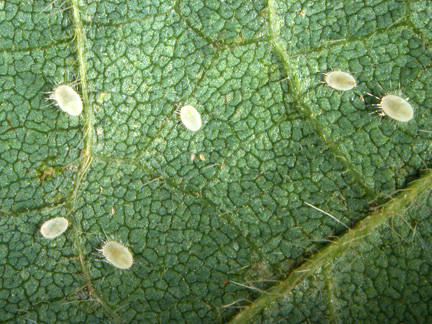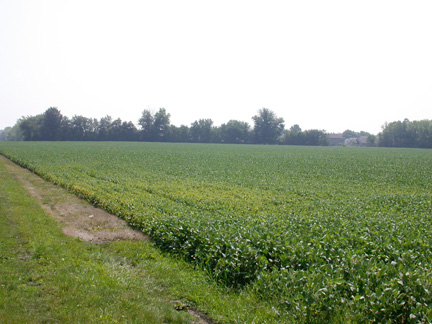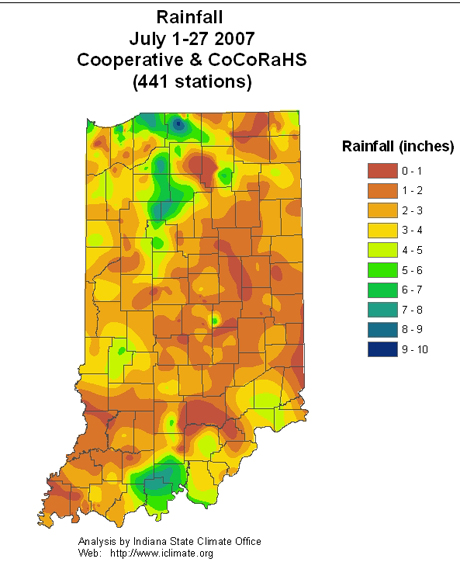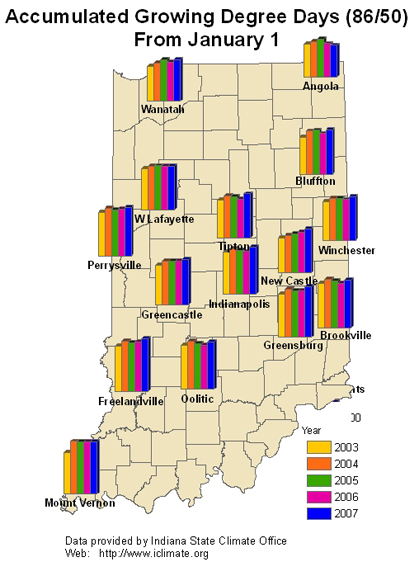Pest & Crop Newsletter, Entomology Extension, Purdue University
- Soybean Aphid Activity Picking Up
- Another Soybean Aphid Look-Alike
- Not All Yellow Beans Are Caused By Spider Mites
- Black Light Trap Catch Report
![]()
Soybean Aphid Activity Picking Up – (Christian Krupke, John Obermeyer, and Larry Bledsoe)
- Scout soybean fields now!
- Numbers vary considerably from field to field.
- Hot temperatures won’t kill aphids.
- Treatment threshold and application guidelines given below.
- White dwarves, showing up again.
For the past several weeks, we have given soybean aphid updates. In the past several days, we have had numbers shoot to near-threshold levels in many areas. Some producers are practicing a zero-tolerance policy and are treating fields that are well below threshold. Because of the tremendous variability in aphid numbers from field to field, diligent scouting NOW can pay big dividends. The following is a quick scouting review. Remember, if your beans are at the R6 growth stage, there is little benefit to treating aphid populations – the plant is already beginning to senesce and any aphids that are there will not impact yield.
Sampling: Count aphids, primarily on the undersides of leaves, on at least 20 plants in various areas of the field. When aphids are just beginning to colonize soybean plants, they will be concentrated on the most active growing points – the newest unrolled leaves and the developing pods.
Aphid Number: Should you find an average of 250 or more aphids/plant during the early soybean reproductive stages (R1-R4), a treatment is justified. Threshold of ≥250 aphids/plant includes a week to get field sprayed. During the seed-fill stages (R5-R6), treatment is not as clear-cut. If aphid numbers are increasing and plants are under stress, however, a treatment is justified. Do NOT treat soybean beyond the R6 stage of growth.

White dwarf soybean aphids

Soybean aphid treatment threshold guide
Weather: High temperatures (90’s) are less than optimal for soybean aphid growth and reproduction, but does not stop them. Rainfall, including some hard downpours, has had some negative effect on aphid populations, but does not wipe them out.
Predators: Most pest managers calling to report aphid numbers are also aware of predator populations. We appreciate their desire to preserve natural enemies and prevent unwarranted pesticide treatments. However, once aphid levels reach over 100 per plant, predators may not be able to keep ahead of the aphid’s reproductive capability.
Treatment: Should control be necessary, complete coverage on the foliage seems to be the key. Ground driven rigs applying at least 20 gallons per acre with 40 PSI at fine to medium droplet size will help penetrate the canopy. Aerial application success is dependent on finished spray volume (we recommend 5 gallon/acre) and air movement into the canopy.
Products labeled for soybean aphid control can be viewed at <http://www.entm.purdue.edu/entomology/ext/targets/e-series/EseriesPDF/e-77.pdf>.
Extension publication “Soybean Aphid,” E-217 may provide further answers to your questions <http://www.entm.purdue.edu/Entomology/ext/targets/e-series/EseriesPDF/E-217.pdf>.
Little, white aphids: By far the most asked questions have been concerning the very small, white aphids. These ARE soybean aphid. They ARE NOT all “baby” aphids. They ARE NOT diseased aphids. Many refer to them as “white dwarves.” Aphids of many different species do this in response to physiological stress of some kind. In the case of soybean aphid, we don’t know for certain what causes this response – it may be due to hot temperatures, higher humidity, shorter day-length, nutritional quality, predator populations, or a combination of all these factors. We do know that they are living, feeding, and reproducing aphids. They should be included in the total plant population count when determining treatment. It appears that they do not feed as heavily or reproduce as quickly as the “normal” green/yellow aphid. It has been noted that because of their size and color, many are missed when making aphids/plant counts.
 Watch a short video on scouting soybean aphid.
Watch a short video on scouting soybean aphid.
 Watch a short video on how to account for "white drawf" aphids while scouting.
Watch a short video on how to account for "white drawf" aphids while scouting.
![]()
Another Soybean Aphid Look-Alike – (Christian Krupke, John Obermeyer, and Larry Bledsoe)
In Pest&Crop issue #13, June 22 <http://extension.entm.purdue.edu/pestcrop/2007/index.html>, we ran an article with pictures of soybean aphid look-alikes. That is, little critters that can be mistaken for soybean aphids if one is not familiar with their identification or just assumes all little things on soybean leaves are aphids. Recently we have seen, and heard of, whiteflies being quite noticeable in some fields. Why their abundance this year is not understood, but we are certain these little suckers are doing little to no damage to the soybean plants. The following pictures may help in their identification.

Whitefly adults on backside of leaflet

Microscopic whitefly nymphs, look very similar to white dwarf soybean aphids without magnification
![]()
Not All Yellow Beans Are Caused By Spider Mites - (Christian Krupke, John Obermeyer, and Larry Bledsoe)
- Many factors caused soybean plants to discolor.
- Determine by scouting that spider mites are the primary cause for yellowing.
While driving through different areas of the state it is amazing the number of soybean fields exhibiting areas of yellow.
A number of factors can cause leaf yellowing. These include, but not limited to, soybean cyst nematode, nutrient deficiencies, poor nodulation, herbicide injury, diseases, compaction, etc. Spider mites may be present along with any of these other plant stressers and may or may not be causing the discolored foliage. In other words, it’s the old chicken and egg dilemma. Stressed plants actually provide a better nutritional feast for spider mites thus they thrive and quickly colonize areas or whole fields. The best spider mite control is to eliminate plant stress, and in the absence of timely rains, this is easier said than done.
Before considering control, it is very important that spider mites are identified as the source of the problem. Shake some discolored soybean leaves over a white piece of paper. Watch for small dark specks moving about on the paper. Also look for very fine webbing on the undersides of the discolored leaves. Once spider mites have been positively identified in the damaged areas of the field, it is essential that the whole field be scouted to determine the range of infestation. Sample in at least five different areas of the field and determine whether the spider mites are present or not by using the “shake” method. Happy scouting!

Yellowing from field edge, not spider mite caused
![]()
Click here to view the
Black Light Trap Catch Report - (John Obermeyer)
![]()
Leaf Cupping and Wrinkling in Soybeans – (Mark Loux, The Ohio State University)
We have received a number of calls about cupping or wrinkling of soybean leaves, and it seems that this has become an annual issue in much of the cornbelt. Some of the symptoms are undoubtedly due to drift or volatility of herbicides due to the many windy days this year, but some are undoubtedly due to other problems as well. A number of factors can cause these symptoms, and it can be difficult to pinpoint the exact cause. Some additional information on this issue follows. There is also a new fact sheet with color photos available from the University of Wisconsin, “Dicamba Injury to Soybeans”, which can be downloaded from <http://ipcm.wisc.edu/Publications/tabid/54/grm2id/32/Default.aspx>.
One of the first herbicides to get blamed in many fields is dicamba, which may have been applied in a nearby corn field. Products containing dicamba include Banvel, Clarity, Marksman, Celebrity Plus, Distinct, Northstar, Status, Yukon, and numerous generic products. Exposure of soybeans to low concentrations of dicamba through drift or volatility, or even dicamba residues in spray tanks may be the culprit in some fields. The potential for volatility varies among these products, but all can drift if applied during windy conditions. However, many of the affected fields seem to be far enough away from treated corn fields, or dicamba was not used in the area, and this possibility can be ruled out. The most typical symptoms from exposure of soybeans to dicamba are puckering of the new leaves that are emerging 7 to 10 days after exposure. This may be accompanied by stunting of the plant. Soybeans may show these symptoms on several trifoliates, and then recover completely. Spray particle drift from Distinct and Status application often causes more severe symptoms than dicamba alone, due to the diflufenzopyr component of Distinct. However, there is little risk of volatilization of diflufenzopyr, while dicamba can volatilize readily depending upon formulation and temperature.
Research indicates that soybean yield is not generally reduced when minor symptoms occur, and yield loss is more likely if soybeans are in the reproductive stage at the time of exposure (although still unlikely unless symptoms are severe). Our research with postemergence soybean herbicides indicates that soybeans can tolerate considerable early-season injury with little or no impact on yield, when rainfall and other environmental conditions are generally favorable for crop growth after the injury has occurred. Yield loss seems to be most likely when herbicides are applied after about the beginning of July, and soybeans are small at the time of application (which might occur from late planting or poor early-season growing conditions). Where this has occurred, soybeans may not recover well enough to attain the size needed for maximum yield potential.
Over the past decade, we have heard reports of and observed fields where leaf puckering or cupping was uniform over the entire field. Other fields have shown symptoms only in some areas. In OSU research plots, we have occasionally observed puckering in Roundup Ready soybeans following application of glyphosate. Spider mites and leafhopper have been known to cause cupping and wrinkling of soybean leaves. Many of the fields with puckering were previously treated with a postemergence herbicide other than glyphosate. ALS-inhibiting herbicides seem to be most often used in fields with the symptoms, but other herbicides have also been used. One working theory about these symptoms - when the postemergence herbicide causes injury to the terminal buds on soybeans, apical dominance is altered, and plant hormones are redistributed within the plant. The result is the appearance of injury that is similar to that from plant growth regulator herbicides (dicamba, 2,4-D). New shoots may occur at nodes below the injured zone, the plant may take on more of a bushy appearance, and leaves may be wrinkled and cupped. However, most of the fields have not exhibited the increased “bushiness” that might occur if apical dominance was lost.
While herbicides may be responsible for some of the puckering, cupping, and wrinkling that has been observed, we suspect that environmental conditions and soybean variety may have a significant role. This is based on the observation of uniform cupping in fields where no postemergence herbicide was used. Some varieties may be more likely to show symptoms than others. We have not been able to come up with a good explanation for this phenomenon. However, the good news is that leaf cupping and wrinkling generally should not affect yields, and soybeans generally compensate well from other herbicide-related problems given enough time and moisture.
![]()
Online Resources Offer Heaps of Information on Grain Piling – (Ag Answers)
Indiana farmers piled on the corn acreage this year and, come harvest, they might be piling much of the grain on the ground.
A Purdue University online resource can help producers with their outdoor storage decisions.
“If you’re looking at putting a temporary outdoor pile structure together, whether it’s round or rectangular or elongated, there’s a spreadsheet that we call the Outdoor Pile Volume Calculator,” said Dirk Maier, Purdue Extension agricultural engineer. “With the spreadsheet, you can calculate angles of repose, capacity calculations, the function of the sidewalls and those types of things.”
The free spreadsheet is available at <http://cobweb.ecn.purdue.edu/~grainlab/exten-pubs.htm#Emergency>.
Hoosier producers planted a record 6.6 million acres of corn this spring, a 20 percent jump from 2006 acreage, according to the Indiana Agricultural Statistics Service. High corn prices brought on by the rapid expansion of the ethanol industry drove the acreage jump.
Producers with empty farm buildings could convert them into makeshift grain bins, Maier said. Another free spreadsheet - the Dry Grain Aeration Systems Design Tool - provides valuable information. The spreadsheet is located at <http://cobweb.ecn.purdue.edu/~grainlab/exten-pubs.htm#Designing>.
“The spreadsheet tool allows you to design an aeration system for everything from a round storage structure all the way to flat storage buildings and outdoor systems,” Maier said. “The spreadsheet goes with a handbook that’s available from the MidWest Plan Service on aeration system design. All the calculations that are outlined in the book are programmed into the spreadsheet.”
The handbook is part of a new grain handling reference library offered by the MidWest Plan Service. For more information or to order, visit the organization’s Web site at
<http://www.mwps.org/>.
Regardless of whether they place their grain in buildings specifically designed for storage or in temporary storage facilities, farmers need to handle the grain properly, Maier said. He recommends producers follow a four-step process called “S.L.A.M.”
“We talk about four best management practices that we categorize under sanitation, loading, aeration and monitoring,” Maier said.
“Sanitation refers to all of the preparation of the storage structures, making sure they are structurally sound, clean inside and out, and that they have all the necessary equipment such as aeration equipment and loading and unloading equipment in place and functional before we put any grain in the bin.
“As we get closer to harvest, we need to think of loading the grain into the bin. We don’t want to allow the grain to just sit there but, instead, we want to core it and take the fine material and peak out.”
Aeration involves cooling the grain when outdoor temperatures are 10-15 degrees cooler than the grain itself. Monitoring is important so that insects or grain spoilage can be detected before grain quality is lost.
Producers can learn more about S.L.A.M. by reading Purdue Extension publication ID-207, “Maximize Grain Quality and Profits Using S.L.A.M.: The Post-Harvest IPM Strategy,” by Maier, Purdue entomologist Linda Mason and Purdue plant pathologist Charles Woloshuk. The publication is available online at <http://www.ces.purdue.edu/extmedia/ID/ID-207.html>.
Additional grain handling tips are available at the Purdue Post-Harvest Grain Quality and Stored Product Protection Program Web site, located at <http://www.grainquality.org>.
![]()



